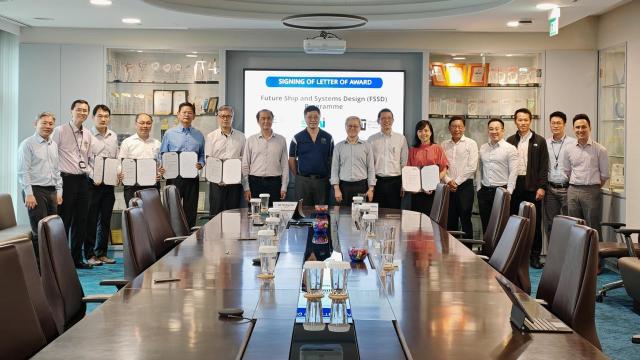Two SIT teams were honoured for their entries at the 6th Eldercare Innovation Awards held in conjunction with the 9th International Ageing Asia Innovation Forum 2018 in May. Touted as the 'Oscars of the Eldercare Industry', the award is the only one of its kind in the Asia Pacific region that recognises the best in innovative eldercare product and service delivery.

Associate Professor Patrick Chua (centre) and Assistant Professor Agnes Xue (2nd from left) with the awards recipients.
As Project Lead for the Smart Walker for Gait Rehabilitation with Local Positioning System, Associate Professor Patrick Chua, Engineering, SIT clinched the award in the 'Best Smart Care Technology – Product' category on behalf of the team. As a final year project of Ms Koh Min Merissa who is reading her Bachelor of Engineering with Honours in Mechatronics (SIT-UofG), it is the result of a continued multidisciplinary collaboration with Kwong Wai Shiu Hospital (KWSH).
 Together with A/Prof Zheng Jianxin, Programme Director, Engineering and Tan Hong Yong, Professional Officer, all four provided valuable inputs to produce the innovative smart walker that independently aids a patient undergoing rehabilitation. This means a patient does not need the physical support of physiotherapists all the time. Therapists would be able to manage and monitor the patient using the smart walker from a remote laptop. The system monitors and records the walking activities as well as locates the positions of patients using the smart walkers. This is particularly useful in countries with limited and overwhelmed rehab facilities as it provides an innovative solution to the manpower crunch faced by the healthcare industry.
Together with A/Prof Zheng Jianxin, Programme Director, Engineering and Tan Hong Yong, Professional Officer, all four provided valuable inputs to produce the innovative smart walker that independently aids a patient undergoing rehabilitation. This means a patient does not need the physical support of physiotherapists all the time. Therapists would be able to manage and monitor the patient using the smart walker from a remote laptop. The system monitors and records the walking activities as well as locates the positions of patients using the smart walkers. This is particularly useful in countries with limited and overwhelmed rehab facilities as it provides an innovative solution to the manpower crunch faced by the healthcare industry.
"This is indeed a prestigious award and a very proud moment for SIT and our industry partner, KWSH, as we managed to come out tops amongst other esteemed organisations from the Asia Pacific region. I would like to thank University of Glasgow for facilitating this Smart Walker project and giving me the opportunity to train and lead final year students to venture beyond their classroom environment," said A/Prof Patrick Chua.
Making it to the top five finalists for the same category was Assistant Professor Agnes Xue, Deputy Programme Director, Design and Specialised Businesses, with her entry of an arm-skate device named the New Arm.
The faculty-and-student project was the innovative solution to METTA Day Rehabilitation Centre for the Elderly's challenge to design a device for post-stroke patients to regain upper limb mobility. A collaboration between the Engineering, Health and Social Sciences, and Design and Specialised Businesses Clusters in SIT, the innovation is the result of one-and-a-half-year's findings of four students from the design, engineering and occupational therapy disciplines.
"Our work relies on a multidisciplinary approach and puts the user at the centre of the design process. For an added fun element, we incorporated a virtual reality game to provide an incentivised, goal-directed task to motivate patients to move their arm. Being awarded top five is a major milestone. It gives me and my team confidence that our design is well suited to improve the quality of life for our patients", said Asst Prof Agnes Xue.

A post-stroke patient using the New Arm to regain upper limb mobility.
![[FA] SIT One SITizen Alumni Initiative_Web banner_1244px x 688px.jpg](/sites/default/files/2024-12/%5BFA%5D%20%20SIT%20One%20SITizen%20Alumni%20Initiative_Web%20banner_1244px%20x%20688px.jpg)


